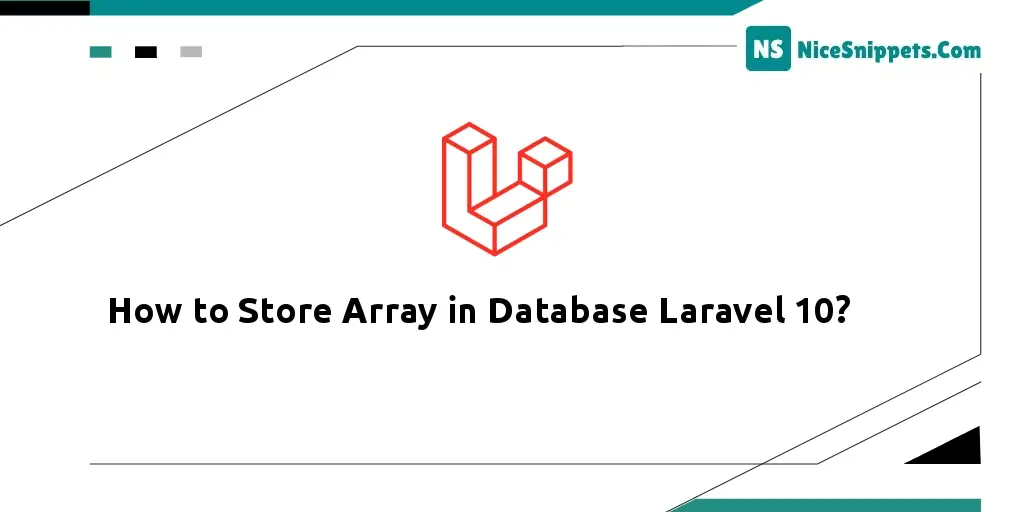14-Jun-2023
.
Admin

Hi dev,
You will discover how to store an array in a Laravel database in this article. I simply broke you how to store an array in a database step by step. You will discover how to use Laravel to save array data in a database here. I provided a clear explanation of how to store an array in a Laravel database.
You can use this example with laravel 6, laravel 7, laravel 8, laravel 9 and laravel 10 version.
In some cases, having vast amounts of data or unfixed columns prevents us from adding too many nullable fields to a database table. Therefore, in order to store values that are huge or unstructured, we must utilise the JSON data type. I'll give you a straightforward example of how to store a JSON array and access it from the database in Laravel if you want to store a JSON array in a database.
In this example, first, we will create migration with a JSON column. Then we will create a model with a getter and setter. when you create records then you can pass them as an array and when you get records then you will find an array. so let's see a simple example and learn it.
Step 1: Install Laravel
This is optional; however, if you have not created the laravel app, then you may go ahead and execute the below command:
composer create-project laravel/laravel example-app
Step 2: Create Migration
Here, we need create database migration for "items" table with title and data(JSON Column) columns and also we will create model for items table.
php artisan make:migration create_items_table
database/migrations/2022_07_11_141714_create_items_table.php
<?php
use Illuminate\Database\Migrations\Migration;
use Illuminate\Database\Schema\Blueprint;
use Illuminate\Support\Facades\Schema;
return new class extends Migration
{
/**
* Run the migrations.
*
* @return void
*/
public function up()
{
Schema::create('items', function (Blueprint $table) {
$table->id();
$table->string('title');
$table->json('data')->nullable();
$table->timestamps();
});
}
/**
* Reverse the migrations.
*
* @return void
*/
public function down()
{
Schema::dropIfExists('items');
}
};
Then run migration command to create items table.
php artisan migrate
Step 3: Create Model
In this step, we will create Item.php model with getter setter. let's create model and update following code:
php artisan make:model Item
App/Models/Item.php
<?php
namespace App\Models;
use Illuminate\Database\Eloquent\Factories\HasFactory;
use Illuminate\Database\Eloquent\Model;
use Illuminate\Database\Eloquent\Casts\Attribute;
class Item extends Model
{
use HasFactory;
/**
* Write code on Method
*
* @return response()
*/
protected $fillable = [
'title', 'data'
];
/**
* Get the user's first name.
*
* @return \Illuminate\Database\Eloquent\Casts\Attribute
*/
protected function data(): Attribute
{
return Attribute::make(
get: fn ($value) => json_decode($value, true),
set: fn ($value) => json_encode($value),
);
}
}
Step 4: Create Route
In third step, we will create one route for testing. so create one route here.
routes/web.php
<?php
use Illuminate\Support\Facades\Route;
use App\Http\Controllers\ItemController;
/*
|--------------------------------------------------------------------------
| Web Routes
|--------------------------------------------------------------------------
|
| Here is where you can register web routes for your application. These
| routes are loaded by the RouteServiceProvider within a group which
| contains the "web" middleware group. Now create something great!
|
*/
Route::get('item', [ItemController::class, 'index']);
Step 5: Create Controller
In this step, we will create ItemController file and write index() method to create item records with array and access as array.
app/Http/Controllers/ItemController.php
<?php
namespace App\Http\Controllers;
use Illuminate\Http\Request;
use App\Models\Item;
class ItemController extends Controller
{
/**
* Write code on Method
*
* @return response()
*/
public function index()
{
$input = [
'title' => 'Demo Title',
'data' => [
'1' => 'One',
'2' => 'Two',
'3' => 'Three'
]
];
$item = Item::create($input);
dd($item->data);
}
}
Run Laravel App:
All the required steps have been done, now you have to type the given below command and hit enter to run the Laravel app:
php artisan serve
Now, Go to your web browser, type the given URL and view the app output:
http://localhost:8000/item
You can see database output and print variable output:
Output:
array:3 [
1 => "One"
2 => "Two"
3 => "Three"
]
I hope it can help you...
#Laravel 10